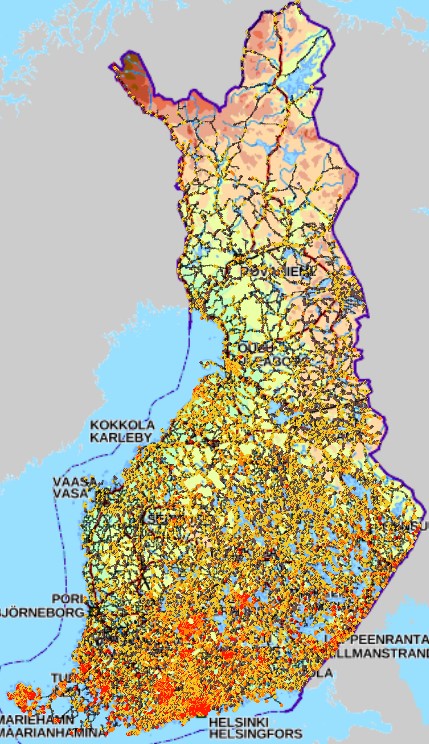dataset
Type of resources
Available actions
Topics
Keywords
Contact for the resource
Provided by
Years
Formats
Representation types
Update frequencies
status
Service types
Scale
Resolution
-

FIN Aineiston tarkoituksena on: -Identifioida tie- ja rata-alueet, joiden varrella esiintyy uhanalaisia ja silmälläpidettäviä lajeja -Identifioida tie- ja rata-alueet, joiden varrella esiintyy hyviä elinvoimaisia niittyindikaattorilajeja (hyönteisten mesi- ja ravintokasveja) -Identifioida tie- ja rata-alueet, joiden varrella esiintyy suojelualueita -Identifioida tie- ja rata-alueet, joiden varrella esiintyy komealupiinia tai kurtturuusua -Identifioida tie- ja rata-alueet, joiden varrella esiintyy komealupiinia tai kurtturuusua uhanalaisten lajien lisäksi -> Löytää herkät alueet ja paikallistaa vieraslajien uhka Tieto esitetään 1 kilometrin ruuduissa. Aineistosta on julkaistu kaksi erillistä versiota. -VaylanvarsienVieraslajitJaArvokkaatElinymparistot_avoin: Avoin versio, jonka lajitietoa on karkeistettu mahdollisista herkistä lajeista johtuen. Aineisto kuuluu SYKEn avoimiin aineistoihin (CC BY 4.0) ja sitä saa käyttää lisenssiehtojen mukaisesti -VaylanvarsienVieraslajitJaArvokkaatElinymparistot_kayttorajoitettu: Alkuperäinen karkeistamaton versio. Tämä versio on vain viranomaiskäyttöön eikä kyseistä aineistoa saa jakaa Aineistosta on tehty tarkempi menetelmäkuvaus https://geoportal.ymparisto.fi/meta/julkinen/dokumentit/VierasVayla_Menetelmakuvaus.pdf sekä muuttujaseloste https://geoportal.ymparisto.fi/meta/julkinen/dokumentit/VierasVayla_VariableDescription.xlsx ENG The purpose of the material is to: -Identify road and rail areas that have nearby observations of endangered and near threatened species -Identify road and rail areas with good meadow indicator plant species -Identify road and rail areas along which there are protected areas -Identify the road and rail areas along which there are observations of Lupinus polyphyllus or Rosa rugosa observations -Identify the road and rail areas along which there are Lupinus polyphyllus or Rosa rugosa observations in addition to sensitive species -> Finds sensitive areas and identify the overall threat of alien species The data is presented in 1-kilometer square grid cells. There are two separate versions of the data. -VaylanvarsienVieraslajitJaArvokkaatElinymparistot_avoin: Open access version, in which its species-related parts have been simplified due to data restriction issues. The material belongs to Syke's open materials (CC BY 4.0) and may be used in accordance with the license terms. -VaylanvarsienVieraslajitJaArvokkaatElinymparistot_kayttorajoitettu: Original version. This version is only for official use and the material in question may not be shared. A more precise description about the data procedures can be found from (In Finnish) https://geoportal.ymparisto.fi/meta/julkinen/dokumentit/VierasVayla_Menetelmakuvaus.pdf Furthermore, all the variables in the data are explained in this bilingual variable description https://geoportal.ymparisto.fi/meta/julkinen/dokumentit/VierasVayla_VariableDescription.xlsx This dataset was updated with the newest species observations on 10/2023 and 11/2024 Process code for this can be found from https://github.com/PossibleSolutions/VierasVayla_SpeciesUpdate
-

FIN Suomen hiekkarantoja ja niiden taustatekijöitä kuvaava aineisto. Datan taustalla olevan hankkeen pääasiallisena tarkoituksena on hiekkarantojen identifioiminen parhaasta käytettävissä olevasta tiedosta, näiden rantojen ominaispiirteiden kuvaaminen, ympäristöllisen arvon arvioiminen sekä hoitotarpeessa olevien rantojen löytäminen. Aineistosta on julkaistu kaksi erillistä versiota. -HiekkarantojenOminaisuudet_avoin: Avoin versio, jonka lajitietoa on karkeistettu mahdollisista herkistä lajeista johtuen. Aineisto kuuluu SYKEn avoimiin aineistoihin (CC BY 4.0) ja sitä saa käyttää lisenssiehtojen mukaisesti -HiekkarantojenOminaisuudet_kayttorajoitettu: Alkuperäinen karkeistamaton versio. Tämä versio on vain viranomaiskäyttöön eikä kyseistä aineistoa saa jakaa” Aineistosta on tehty tarkempi menetelmäkuvaus https://geoportal.ymparisto.fi/meta/julkinen/dokumentit/RantaPutte_Menetelmakuvaus.pdf sekä muuttujaseloste https://geoportal.ymparisto.fi/meta/julkinen/dokumentit/RantaPutte_VariableDescription.xlsx ENG This data describes Finnish sandy beaches and their background factors. The main purpose of the project underlying the data is to identify sandy beaches from the best available information, to describe the characteristics of these beaches, to assess their environmental value and to find beaches in need of conservation There are two separate versions of the data. -HiekkarantojenOminaisuudet_avoin: Open access version, in which its species-related parts have been simplified due to data restriction issues. The material belongs to Syke's open materials (CC BY 4.0) and may be used in accordance with the license terms. -HiekkarantojenOminaisuudet_kayttorajoitettu: Original version. This version is only for official use and the material in question may not be shared. A more precise description about the data procedures can be found from (In Finnish) https://geoportal.ymparisto.fi/meta/julkinen/dokumentit/RantaPutte_Menetelmakuvaus.pdf All the variables in the data are explained in this bilingual variable description https://geoportal.ymparisto.fi/meta/julkinen/dokumentit/RantaPutte_VariableDescription.xlsx
-
The EMODnet (European Marine Observation and Data network) Geology project collects and harmonizes marine geological data from the European sea areas to support decision making and sustainable marine spatial planning. The partnership includes 39 marine organizations from 30 countries. The partners, mainly from the marine departments of the geological surveys of Europe (through the Association of European Geological Surveys-EuroGeoSurveys), have assembled marine geological information at various scales from all European sea areas (e.g. the White Sea, Baltic Sea, Barents Sea, the Iberian Coast, and the Mediterranean Sea within EU waters). This dataset includes EMODnet seabed substrate maps at a scale of 1:60 000 from the European marine areas. Traditionally, European countries have conducted their marine geological surveys according to their own national standards and classified substrates on the grounds of their national classification schemes. These national classifications are harmonised into a shared EMODnet schema using Folk's sediment triangle with a hierarchy of 16, 7 and 5 substrate classes. The data describes the seabed substrate from the uppermost 30 cm of the sediment column. Further information about the EMODnet Geology project is available on the portal (http://www.emodnet-geology.eu/).
-
NLS-FI INSPIRE Geographical Names Theme Dataset is a dataset depicting the Named Places and Geographical Names covering the whole of Finland. It contains the following INSPIRE feature types: NamedPlace The elements are updated weekly. The dataset is based on the Geographic Names Register of the National Land Survey of Finland: http://www.paikkatietohakemisto.fi/geonetwork/srv/fin/catalog.search#/metadata/eec8a276-a406-4b0a-8896-741cd716ade6 The dataset is available via the NLS-FI INSPIRE Download Service (WFS) for Geographical Names Theme and it can be viewed via the NLS-FI INSPIRE View Service (WMS) for Geographical Names.
-
The EMODnet (European Marine Observation and Data network) Geology project collects and harmonizes marine geological data from the European sea areas to support decision making and sustainable marine spatial planning. The partnership includes 39 marine organizations from 30 countries. The partners, mainly from the marine departments of the geological surveys of Europe (through the Association of European Geological Surveys-EuroGeoSurveys), have assembled marine geological information at various scales from all European sea areas (e.g. the White Sea, Baltic Sea, Barents Sea, the Iberian Coast, and the Mediterranean Sea within EU waters). This dataset includes EMODnet seabed substrate maps at a scale of 1:45 000 from the European marine areas. Traditionally, European countries have conducted their marine geological surveys according to their own national standards and classified substrates on the grounds of their national classification schemes. These national classifications are harmonised into a shared EMODnet schema using Folk's sediment triangle with a hierarchy of 16, 7 and 5 substrate classes. The data describes the seabed substrate from the uppermost 30 cm of the sediment column. Further information about the EMODnet Geology project is available on the portal (http://www.emodnet-geology.eu/).
-
FIN Järvien vesikasvillisuusvyöhykettä kuvaava aineisto 1971 suomalaisesta järvivesimuodostumasta. Aineisto on polygonivektorimuodossa, jossa yksittäisen järven vesikasvivyöhyke esitetään moniosaisena polygonina. Vesikasvillisuusvyöhyke koostuu ilmakuvilta erottuvasta vedenpinnan yläpuolisesta (ilmaversoinen ja kelluslehtinen) ja aivan vedenpinnan tasolle yltävästä uposlehtisestä kasvillisuudesta. Vesikasvillisuusvyöhykkeen ja järven 0–3 metrin syvyysvyöhykkeen perusteella järville on laskettu kasvittumisaste-niminen tunnusluku, jota käytetään järvien ekologisen tilan arvioinnissa kuvaamaan rehevöitymisen aiheuttamaa kasvillisuuden runsastumista. Vesikasvillisuusvyöhyke on analysoitu Picterra-yrityksen koneoppimismalleilla Maanmittauslaitoksen hallinnoimista väri-infra- eli vääräväriortokuvista vuosilta 2012-2023. Vyöhykkeen analysointi on rajattu 1.7.–10.9. otettuihin ortokuviin. Lisäksi analysointi on rajattu seuraaviin vesienhoidon suunnittelun 3. suunnittelukaudella määritettyihin järvityyppeihin: • Pienet humusjärvet • Keskikokoiset humusjärvet • Runsashumuksiset järvet • Matalat humusjärvet • Matalat runsashumuksiset järvet Aineisto sisältää 698 järvivesimuodostumalta ilmakuvatulkinnan useammalta vuodelta. Havaittu kasvittumisaste on laskettu niille 977 järvivesimuodostumalle, joilta oli saatavissa tieto 0–3 metrin syvyysvyöhykkeestä. Aineistoon on jätetty järviä ilman syvyysaineistoa ja siten kasvittumisasteen laskentaa siinä tarkoituksessa, jotta aineistoa voidaan tarvittaessa hyödyntää muuhunkin kuin kasvittumisaste-muuttujaan perustuvaan tila-arviointiin. Aineistolle on tehty silmämääräinen tarkastus virheellisten havaintojen poistamiseksi. Aineisto voi silti sisältää väärintulkintoja. Kasvittumisasteen luontaisen vaihtelun mallintamisesta saadut tunnusluvut, kuten odotetut kasvittumisasteet ja kasvittumisasteeseen perustuva ekologinen tilaluokka, ovat ympäristöhallinnon asiantuntijoiden katseltavissa Pisara-järjestelmässä. Käyttötarkoitus: Ympäristöhallinnon tehtävien tueksi vesien tilan arviointiin. Järvien ekologisen tilan arviointia tekevät asiantuntijat käyttävät paikkatietoaineistoa ilmakuvatulkinnan laadun arvioimiseen yksittäisellä järvellä. Asiasanat: kaukokartoitus, ilmakuvat, vesikasvillisuus, seuranta, ekologinen tila Lisätietoja: https://geoportal.ymparisto.fi/meta/julkinen/dokumentit/Jarvien_vesikasvillisuusvyohykkeet.pdf https://vesi.fi/aineistopankki/koneoppimispohjaiseen-ilmakuvatulkintaan-perustuva-jarvien-vesikasvillisuuden-tilanarviointi/ ENG This data describes lake macrophyte zone on 1971 Finnish lake waterbodies. The spatial features are represented as multi-part polygons. The attributes are in Finnish. The zone represents emergent and floating-leaved vegetation plus submerged vegetation just above the surface of water. Together with lake bathymetric data, the percentage of vegetated littoral (PVL) was calculated. The PVL is applied in ecological status assessment. Lake macrophyte zone was detected from color-infrared aerial orthophotos administered by the National Land Survey of Finland. The detections were performed with the help of a custom machine learning model trained using Picterra. The detections were applied to orthophotos in 2012-2013 which were filmed between 1st of July and 10th of September. The detections were limited to humic and humic-rich lake waterbodies. There are detections from multiple years for 698 lake waterbodies. Observed PVL were calculated on 977 lake waterbodies which have bathymetric data to identify the 0 to 3 meters deep littoral zone. To potentially utilize the data for more than just the PVL-based approach, the data also have detections on waterbodies without bathymetric data and therefore observed PVL. A visual inspection of the data has been performed to remove erroneous detections. The data may still contain misinterpretations. Purpose of use: Support of environmental administration in ecological status assessment. More information: https://geoportal.ymparisto.fi/meta/julkinen/dokumentit/Jarvien_vesikasvillisuusvyohykkeet.pdf https://vesi.fi/aineistopankki/koneoppimispohjaiseen-ilmakuvatulkintaan-perustuva-jarvien-vesikasvillisuuden-tilanarviointi/
-
NLS-FI INSPIRE Buildings Theme Dataset is a dataset depicting the Buildings covering the whole of Finland. It contains the following INSPIRE feature types: Building The elements are updated weekly. The dataset is based on the NLS Topographic database: http://www.paikkatietohakemisto.fi/geonetwork/srv/en/main.home?uuid=cfe54093-aa87-46e2-bfa2-a20def7b036f. Id-attribute indicates the topographic database id for features (mtk-id). The dataset is available via the NLS-FI INSPIRE Download Service (WFS) for Buildings Theme and it can be viewed via the NLS-FI INSPIRE View Service (WMS) for Buildings.
-
The technical harvesting potential of small-diameter trees can be defined as the maximum potential procurement volume of small-diameter trees available from the Finnish forests based on the prevailing guidelines for harvesting of energy wood. The potentials of small-diameter trees from early thinnings have been calculated for fifteen NUTS3-based Finnish regions covering the whole country (Koljonen et al. 2017). To begin with the estimation of the region-level potentials, technical harvesting potentials were estimated using the sample plots of the eleventh national forest inventory (NFI11) measured in the years 2009–2013. First, a large number of sound and sustainable management schedules for five consecutive ten-year periods were simulated for each sample plot using a large-scale Finnish forest planning system known as MELA (Siitonen et al. 1996; Redsven et al. 2013). MELA simulations consisted of natural processes and human actions. The ingrowth, growth, and mortality of trees were predicted based on a set of distance-independent tree-level statistical models (e.g. Hynynen et al. 2002) included in MELA and the simulation of the stand (sample plot)-level management actions was based on the current Finnish silvicultural guidelines (Äijälä et al. 2014) and the guidelines for harvesting of energy wood (Koistinen et al. 2016). Simulated management actions for the small-tree fraction consisted of thinnings that fulfilled the following stand criteria: • mean diameter at breast height ≥ 8 cm • number of stems ≥ 1500 ha-1 • mean height < 10.5 m (in Lapland) or mean height < 12.5 m (elsewhere). Energy wood was harvested as delimbed (i.e. including the stem only) in spruce-dominated stands and peatlands and as whole trees (i.e. including stem and branches) elsewhere. When harvested as whole trees, a total of 30% of the original crown biomass was left onsite (Koistinen et al. 2016). Energy wood thinnings could be integrated with roundwood logging or carried out independently. Second, the technical energy wood potential of small trees was operationalized in MELA by maximizing the removal of thinnings in the first period. In this way, it was possible to pick out all small tree fellings simulated in the first period despite, for example, the profitability of the operation. However, a single logging event was rejected if the energy wood removal was lower than 25 m³ha-1 or the industrial roundwood removal of pine, spruce, or birch exceeded 45 m³ha-1. The potential calculated in this way contained also timber suitable for industrial roundwood. Therefore, two estimates are given: • potential of trees below 10.5 cm in breast-height diameter • potential of trees below 14.5 cm in breast-height diameter. Subsequently, the region-level potentials were spread on a raster grid at 1 km × 1 km resolution. Only grid cells on Forests Available for Wood Supply (FAWS) were considered in this operation. In this study, FAWS was defined as follows: First, forest land was extracted from the Finnish Multi-Source National Forest Inventory (MS-NFI) 2013 data (Mäkisara et al. 2016). Second, restricted areas were excluded from forest land. The restricted areas consisted of nationally protected areas (e.g. nature parks, national parks, protection programme areas) and areas protected by the State Forest Enterprise. In addition, some areas in northernmost Lapland restricted by separate agreements between the State Forest Enterprise and stakeholders were left out from the final data. Furthermore, for small trees, FAWS was further constrained by the stand criteria presented above to represent similar stand conditions for small-tree harvesting as in MELA. Finally, the region-level potentials were distributed to the grid cells by weighting with MS-NFI stem wood biomasses. References Äijälä O, Koistinen A, Sved J, Vanhatalo K, Väisänen P (2014) Metsänhoidon suositukset [Guidelines for sustainable forest management]. Metsätalouden kehittämiskeskus Tapion julkaisuja. Hynynen J, Ojansuu R, Hökkä H, Salminen H, Siipilehto J, Haapala P (2002) Models for predicting the stand development – description of biological processes in MELA system. The Finnish Forest Research Institute Research Papers 835. Koistinen A, Luiro J, Vanhatalo K (2016) Metsänhoidon suositukset energiapuun korjuuseen, työopas [Guidelines for sustainable harvesting of energy wood]. Metsäkustannus Oy, Helsinki. Koljonen T, Soimakallio S, Asikainen A, Lanki T, Anttila P, Hildén M, Honkatukia J, Karvosenoja N, Lehtilä A, Lehtonen H, Lindroos TJ, Regina K, Salminen O, Savolahti M, Siljander R (2017) Energia ja ilmastostrategian vaikutusarviot: Yhteenvetoraportti. [Impact assessments of the Energy and Climate strategy: The summary report.] Publications of the Government´s analysis, assessment and research activities 21/2017. Mäkisara K, Katila M, Peräsaari J, Tomppo E (2016) The Multi-Source National Forest Inventory of Finland – methods and results 2013. Natural resources and bioeconomy studies 10/2016. Redsven V, Hirvelä H, Härkönen K, Salminen O, Siitonen M (2013) MELA2012 Reference Manual. Finnish Forest Research Institute. Siitonen M, Härkönen K, Hirvelä H, Jämsä J, Kilpeläinen H, Salminen O, Teuri M (1996) MELA Handbook. Metsäntutkimuslaitoksen tiedonantoja 622. ISBN 951-40-1543-6.
-
The 1:250 000 data on the soft and hard areas of the seabed supplements the seabed substrate data produced by the Geological Survey of Finland (GTK) for areas for which actual survey data is unavailable. The data covers two categories; hard and soft seabed areas. The substrate types categorised as hard seabed areas cover types ranging from gravel to boulders and exposed rock, and the substrate types for soft seabed areas cover types from silt to sand. The model is based on the marine geological survey data of GTK, the substrate observations made by the Finnish Environment Institute (SYKE) and Metsähallitus, and on the environment variable data produced by the Finnish Inventory Programme for the Underwater Marine Environment, VELMU, particularly on depth and seabed openness models. The data has undergone statistical evaluation and the ultimate model is based on expert estimates and modelling. At its most precise, the data is at a scale of 1:250 000 and the areas with a size less than 0.3 square kilometres have been removed. The substrate type information pertaining to restricted areas has been removed from the final data. A permit (AK15246) for publishing data with a similar scale, i.e. the EMODnet data, was received from the Defence Command of the Finnish Defence Forces on 28 July 2014.
-
KUVAUS: Karttataso sisältää sekajätteen keräysalueet, jotka tulevat voimaan kuudessa vaiheessa 31.12.2029 mennessä, sekä nykyisen voimassa olevan sekajätteen keräysalueen. PÄIVITYS: Satunnainen (vain tarvittaessa). YLLÄPITOSOVELLUS: Tampereen kaupungin tiedostopalvelin ja PostGIS-tietokanta KOORDINAATTIJÄRJESTELMÄ: Aineisto tallennetaan ETRS-GK24FIN (EPSG:3878) tasokoordinaattijärjestelmässä GEOMETRIA: vektori (alue) SAATAVUUS: Aineisto on tallennettu Postgis-tietokantaan. JULKISUUS: Aineisto on nähtävillä julkisesti kaikille käyttäjille Oskari-karttapalvelussa. TIETOSUOJA: Aineistoon ei liity tietosuojakysymyksiä. AINEISTOSTA VASTAAVA TAHO: Tampereen kaupunki, Alueellinen jätehuoltolautakunta, jatehuoltolautakunta@tampere.fi
 Paikkatietohakemisto
Paikkatietohakemisto